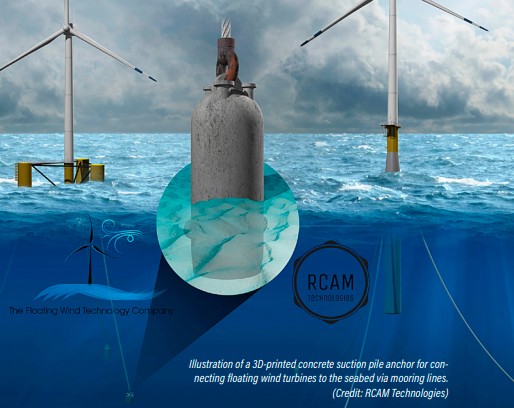Bioinspired Design
3D technology shows promise for durable, lightweight structural materials
Whether it's drawing inspiration from a bone's microstructure or aiding in harnessing renewable energy, researchers at Purdue University are consistently seeking new ways to innovate with 3D-printed materials.
Pablo Zavattieri, the Jerry M. and Lynda T. Engelhardt Professor in Civil Engineering, has spent much of his research over the past several years on the innovation and application of 3D-printed materials. Just this past year alone, he and his teams have produced a pair of reports that could both push materials research forward and lead to a boom in offshore wind energy capturing.
Bone-inspired Materials
What do bones and 3D-printed buildings have in common? They both have columns and beams on the inside that determine how long they last.
Now, the discovery of how a "beam" in human bone material handles a lifetime's worth of wear and tear could translate to the development of 3D-printed lightweight materials that last long enough for more practical use in buildings, aircraft and other structures.
"Bone is a building," Zavattieri said. "It has these columns that carry most of the load and beams connecting the columns. We can learn from these materials to create more robust 3D-printed materials for buildings and other structures."
Zavattieri's team, along with researchers from Cornell University and Case Western Reserve University, found that when they mimicked this beam, an artificial material could last up to 100 times longer. The work was financially supported by the National Science Foundation.
Bones get their durability from a spongy structure called trabeculae, which is a network of interconnected vertical plate-like struts and horizontal rod-like struts acting as columns and beams. The denser the trabeculae, the more resilient the bone for everyday activities. But disease and age affect this density.
"When we ran simulations of the bone microstructure under cyclic loading, we were able to see that the strains would get concentrated in these horizontal struts, and by increasing the thickness of these horizontal struts, we were able to mitigate some of the observed strains," said Civil Engineering PhD student Adwait Trikanad.
Applying loads to the bone-inspired 3D-printed polymers confirmed this finding. The thicker the horizontal struts, the longer the polymer would last as it took on load. And, because thickening the struts did not significantly increase the mass of the polymer, researchers believe this design would be useful for creating more resilient lightweight materials.
"To create a stronger material without making it heavier would mean 3D-printed structures could be built in place and then transported," Zavattieri said. "These insights on human bone could be an enabler for bringing more architected materials into the construction industry."

Harnessing offshore wind energy
Wind off the coasts of the U.S. could be used to generate more than double the combined electricity capacity of all the nation's electric power plants, according to the U.S. Office of Energy Efficiency and Renewable Energy.
Unfortunately, building wind turbines offshore is expensive, requiring parts to be shipped at least 30 miles away from a coast. With that in mind, Zavattieri and fellow Purdue researchers Jan Olek, the James H. and Carol H. Cure Professor of Civil Engineering, and Materials Engineering Professor Jeffrey Youngblood, have been conducting research on a way to make these parts out of 3D-printed concrete, a less expensive material that would also allow parts to float to a site from an onshore plant.
"One of the current materials used to manufacture anchors for floating wind turbines is steel," Zavattieri said. "However, finished steel structures are much more expensive than concrete."
Conventional concrete manufacturing methods also require a mold to shape the concrete into the desired structure, which adds to costs and limits design possibilities. 3D-printing would eliminate the expenses of this mold.
Zavattieri's team is working in collaboration with RCAM Technologies, a startup founded to develop concrete additive manufacturing for onshore and offshore wind energy technology, and the Floating Wind Technology Company (FWTC). RCAM Technologies and the FWTC have an interest in building 3D-printed concrete structures including wind turbine towers and anchors. The work also is funded by the National Science Foundation INTERN program.
The team is developing a method that would involve integrating a robot arm with a concrete pump to fabricate wind turbine substructures and anchors. The goal is to understand the feasibility and structural behavior of 3D-printed concrete produced on a larger scale than what the team has previously studied in the lab.
"The idea we have for this project is to scale up some of the bioinspired design concepts we have proven on a smaller scale with the 3D printing of cement paste and to examine them on a larger scale," said Mohamadreza "Reza" Moini (PhD CE '20).
The researchers will determine how gravity affects the durability of the larger-scale 3D-printed structure. The scaling up research could also be applied to optimizing and reinforcing structures in general.
"Printing geometric patterns within the structure and being able to arrange the filaments through it or playing around with distribution of the steel are both possibilities we have considered for optimizing and reinforcing the structures," said Olek.
Amit Varma, the Karl H. Kettelhut Professor of Civil Engineering and director of Bowen Laboratory, and Christopher Williams, an assistant professor of civil engineering, are assisting in deploying the robot as part of the internal project within the Lyles School of Civil Engineering and between the specialty groups of materials engineering and structural engineering.
Research is being conducted in the Robert L. and Terry L. Bowen Laboratory for Large-Scale Civil Engineering Research.
